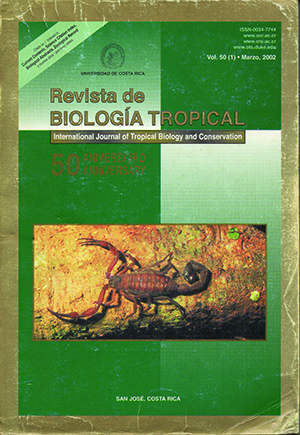Abstract
We report lichen cover change over a 20 years period for the Costa Rican capitol city. Foliaceous lichen cover was measured with a 10 X 10 cm template positioned 1.5 m above ground on the south, east, north and west sides of ten phorophytic trees per station (11 stations) from 1976 through 1997. Results were compared with previous measurements along an urban transect (at three heights above ground) and in a rural station. Lichen cover was correlated with traffic density and varied between stations and years. Mean lichen cover was 23% in 1976, 12% in 1986, 9% in 1990 and 22% in 1997. Most stations suffered a large cover reduction after 1976 but improved after 1990, possibly reflecting improved traffic regulations and elimination of lead (Pb) from gasoline. Cover values by cardinal orientation were: west 17%, east 14%, north 13% and south 12%. Sidewalks of streets with more traffic had lower cover values. In the rural station, cover was lower than expected (possibly because of climate), and was not correlated with height above ground or cardinal orientation, in contrast with temperate regions. In polluted cities human activity should concentrate above the first floor of buildings (particularly in hospitals or schools) because pollution was found to concentrate in the first 2 m above ground.##plugins.facebook.comentarios##

This work is licensed under a Creative Commons Attribution 4.0 International License.
Copyright (c) 2002 Revista de Biología Tropical
Downloads
Download data is not yet available.


